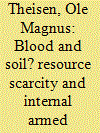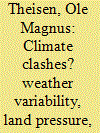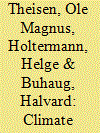|
|
|
Sort Order |
|
|
|
Items / Page
|
|
|
|
|
|
|
| Srl | Item |
| 1 |
ID:
084994


|
|
|
|
|
| Publication |
2008.
|
| Summary/Abstract |
Scarcity of renewable resources is frequently argued to be a main driver of violent conflict. The 2004 and 2007 Nobel Peace Prize awards, as well as the international debate about the implications of climate change, show the salience of the topic as a security issue. Studies testing the link between renewable resource scarcity and armed conflict have reached diverging conclusions. One study, in particular, has found substantial support for eco-scarcity theory, while most others have found a limited association. This article starts with an attempt at replicating earlier findings on the link between population density, soil degradation, deforestation, water scarcity and civil war, but several results are not replicable. The final results lend little support to a purported link between resource scarcity and civil conflict, whereas it replicates earlier findings on the importance of poverty, instability and dependence of fuel exports. A high level of land degradation is the only factor that significantly increases the risk of civil conflict, although this result should be interpreted with caution. The general conclusion of this study is that scarcity of natural resources has limited explanatory power in terms of civil violence, whereas poverty and dysfunctional institutions are robustly related to conflict. Future studies on the link between resource scarcity and violent conflict should focus on local and less intense conflicts, pay more attention to a context of low economic development, look more thoroughly into the role of state actors in the escalatory phase of conflict and assess the importance of the distribution of resources relative to scarcity per se
|
|
|
|
|
|
|
|
|
|
|
|
|
|
|
|
| 2 |
ID:
110807


|
|
|
|
|
| Publication |
2012.
|
| Summary/Abstract |
The evidence of coming climate change has generated catastrophe-like statements of a future where a warmer, wetter, and wilder climate leads to a surge in migrant streams and gives rise to new wars. Although highly popular in policy circles, few of these claims are based on systematic evidence. Using a most-likely case design on Kenya 1989-2004, with new geographically disaggregated data on armed conflicts below the common civil conflict level, this study finds that climatic factors do influence the risk of conflicts and violent events. The effect is opposite to what should be expected from much of the international relations literature; rather, it supports the observations made by recent anthropological studies. Years with below average rainfall tend to have a peaceful effect on the following year and less robustly so for the current year as well. Little support is found for the notion that scarcity of farmland fuels violence in itself or in election years. More densely populated areas - not areas with a low land per capita ratio - run a higher risk of conflict. Election years systematically see more violence, however. The findings therefore support the notion that large-scale intergroup violence is driven by calculation and political gain rather than desperate scrambles for scarce land, pasture, and water resources.
|
|
|
|
|
|
|
|
|
|
|
|
|
|
|
|
| 3 |
ID:
108842


|
|
|
|
|
| Publication |
2011-12.
|
| Summary/Abstract |
Dominant climate models suggest that large parts of Africa will experience greater climatic variability and increasing rates of drought in coming decades. This could have severe societal consequences, because the economies and food supplies of most African countries depend on rain-fed agriculture. According to leading environmental security scholars, policymakers, and nongovernmental organizations, an increase in scarcity-driven armed conflicts should also be expected. A conditional theory of environmental conflict predicts that drought increases the risk of civil war primarily when it strikes vulnerable and politically marginalized populations in agrarian societies. However, an empirical evaluation of this general proposition through a unique gridded dataset of postcolonial Africa, which combines high-resolution meteorological data with georeferenced data on civil war onset and the local ethnopolitical context, shows little evidence of a drought-conflict connection. Instead, the local risk of civil war can be explained by sociopolitical and geographic factors: a politically marginalized population, high infant mortality, proximity to international borders, and high local population density.
|
|
|
|
|
|
|
|
|
|
|
|
|
|
|
|
|
|
|
|
|